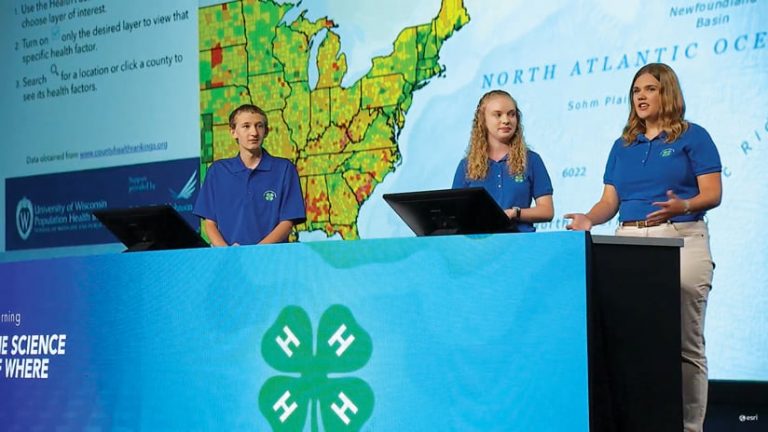Growing up in Good Hope, Georgia, Prather was introduced to agriculture and plenty of outdoor activity. When he wasn’t reading Popular Mechanics and National Geographic, he was living a country boy’s life, working in his dad’s pecan orchard, hunting, fishing, camping, raising steers, and helping out on his grandfather’s 400-acre farm.
“I grew up in farm heritage and spent a lot of my summers over at my granddaddy’s farm. It was probably my favorite place to go,” Prather said. “In the summertime, I’d ride my bike the 15 miles over there and spend the weekend working with his cows, chickens; plowing the soybeans; or mowing the pastures—whatever there was to do.”
While Prather will be the first to say he isn’t a farmer, his family’s farming heritage played a critical role in forming his interest in agriculture and mechanics. When it came time to pursue college, enrolling in the agricultural engineering program at the University of Georgia—just 20 miles down the road—was a natural fit. The program empowered Prather to combine interests in the various engineering disciplines to solve food production problems. After graduating with his master’s degree, Prather joined the University of Tennessee Extension in 1983 as the farm safety specialist and safety coordinator, setting the foundation for a fulfilling 37-year career helping farmers, community members, and students better their lives with technology.
A Career Helping Others
Extension programs, such as the one at UT, came to fruition as a result of the Land-Grant College Act of 1862, or the Morrill Act. This act granted each state 30,000 acres for each of its congressional seats to sell to finance new schools or establish schools of agriculture and mechanic programs at existing universities and colleges, both private and state funded.
Beginning in 1914, land-grant universities were given funding for the Cooperative Extension System (CES). CES, which is administered by the United States Department of Agriculture (USDA), furnishes services through county governments that provide research-based education programs to community farmers. Extension programs include the National AgrAbility Project, 4‑H, beginning farmer programs, and safety education. At some point in his career, Prather would work with all these programs.
As a farm safety specialist and coordinator, Prather offered safety workshops to farmers throughout Tennessee. In 1994, he worked to secure grant funding from the USDA for an AgrAbility Project. This program assists farmers, farmworkers, and their family members with disabilities to live more independent, productive, and profitable lives.
Prather has seen the program’s positive impact firsthand. He recalled a young farmer who was paralyzed after an all-terrain vehicle (ATV) accident on his farm. To continue farming, he needed a lift to help him get off and on his tractor or in and out of his truck without assistance. Through the program, Prather’s team was able to secure the funding for the lift.
“It can take a long time to accomplish these, but when you finally manage to help a young man regain his independence and improve his ability to contribute to the farm operations after an accident like this, it can be life changing,” Prather said. “I am very proud of our team of UT, Tennessee State University, and nonprofits, and that Tennessee AgrAbility was able to operate continuously since 1994.”
Prather’s career evolved to include solar energy education and precision agriculture. After he was introduced to GIS technology, Prather created maps of soil samplings and crop yields and other factors that measure profitability. He used GIS as a tool to make farming more economically and environmentally sustainable.
“I learned about GIS midcareer when I took a class in my department. We were using ArcView [GIS] 3 at the time, and I remember it was exciting to create a map with the data I had collected with GPS or from a farmer’s combine yield monitor,” Prather said.
As someone who wanted to “open his eyes” to the power of spatial thinking, Prather attended his first Esri User Conference (Esri UC) in 2007 where he said he was “blown away” by the future capabilities of GIS and the enthusiasm of Esri founder and president Jack Dangermond.
The conference also introduced Prather to the National 4‑H GIS/GPS Leadership Team and started him on a 14-year journey as a GIS volunteer and mentor. The team consists of 20 to 40 teens and adults from participating states who work together on projects and community mapping programs. Each year, 4‑H students attend Esri UC to present their maps and research and participate in a service-learning project in San Diego, California.
Giving Back as a GIS Volunteer
Whether he was reviewing Esri UC Map Gallery submissions, teaching students how to build a map, or showing them how to collect data with ArcGIS Survey123, Prather has helped students understand the power of GIS. As a 4‑H leader, Prather served as a chaperone to Esri UC and planned the annual student service-learning project in San Diego that is held in conjunction with Esri UC. Some of his favorite service-learning projects were collecting data on invasive plants at the Tijuana Estuary, an intertidal coastal wetland in San Diego County, and mapping signage and illegal hiking trails at the Cabrillo National Monument, located west of the city of San Diego. Prather is committed to sharing his knowledge and time to help students understand the power of GIS and grow as individuals.
“I was just one of several people trying to open their eyes to the power of spatial thinking and give them the tools to present their findings,” Prather said. “I was always excited by the creative projects our members would come up with and how much they grew by doing them. And to see their excitement for GIS during Esri conferences.”
One of Prather’s fondest and proudest memories is of his Tennessee 4‑H GIS team presenting the results of a National 4‑H GIS/GPS Leadership Team research project during the Plenary Session at the 2017 Esri UC. Working with an Esri educator, Prather’s team took project data on obesity rates across the US that had been collected in spreadsheets and analyzed and mapped it using ArcGIS Pro. The team’s analysis explored obesity rates in relation to other health conditions.

While Prather enjoys the students’ GIS achievements, watching them mature, gain confidence, and develop has made the greatest impact on him. Prather recalls a young person who had a difficult upbringing. She was shy, nervous, and lacking in confidence when she joined 4‑H in high school. In her four years with the program, she flourished, becoming a poised and confident young woman. Her project won second place at the state 4‑H project judging and earned her a trip to the National Safety Council Conference & Expo in Las Vegas.
“I still think about her because she is such a great example of what 4‑H, nurturing teachers, and leaders can do for our youth,” Prather said. “I think the skills and confidence that young people gain from the 4‑H opportunities prepare them to be the next generation of leaders, and I am glad to have been a part of it.”
If there is anything that Prather hopes others in the GIS community can learn from his story, it is the importance of giving back to the next generation of leaders.
“I want to encourage others to become a GeoMentor in their community, whether through K–12 schools, 4‑H, Scouts, Big Brothers Big Sisters [of America], or any other youth organization. No matter their expertise or background, they can help open doors for students by showing them what made GIS exciting to work with in the first place. In doing so, you never know how you are making a difference that can change someone’s life,” Prather said.

